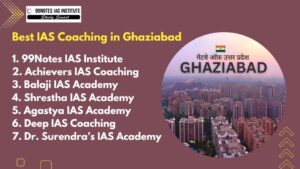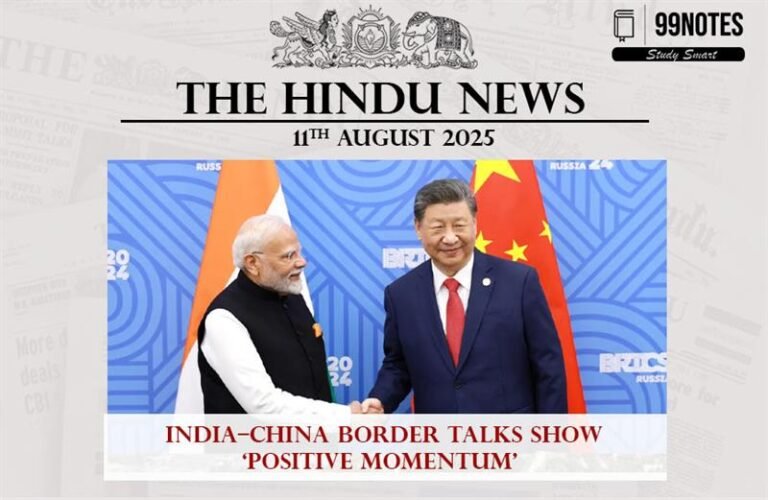18 April 2024 : The Hindu Editorial Notes PDF
The Hindu EDITORIAL
18-April-2024
1. The Great Indian Bustard and climate action verdict
| Topic: GS3 – Environment – Conservations – Important species, GS3 – Environment – Environmental Pollution and Degradation
Understanding Supreme Court’s recognition of climate rights and just transition framework is crucial for environmental jurisprudence and climate governance. |
| Context |
| ● The article discusses the Supreme Court’s recognition of a fundamental right against climate change impacts and advocates for the just transition framework for inclusive climate action. |
Supreme Court Judgment and Recognition of Climate Rights:
- The Supreme Court recognized a fundamental right to be free from the adverse impacts of climate change.
- The judgement addressed the protection of the critically endangered Great Indian Bustard, focusing on the impacts of renewable energy projects.
Limited Articulation of the Right:
- The Court refrained from articulating the right in detail, allowing space for future discourse and informed articulation.
- This departure from past practices signifies judicial restraint and promotes a more nuanced understanding of climate rights.
Just Transition Framework:
- The judgement framed biodiversity protection and climate action as competing choices, posing a challenge.
- Advocating for the just transition framework can reconcile these choices, ensuring equitable and inclusive climate action.
- This approach considers the interests of affected parties, including biodiversity conservation, in transitioning to a low-carbon economy.
Advantages of Using the Just Transition Framework:
- Prevents adversarial choices between biodiversity protection and climate action, fostering inclusive climate action.
- Facilitates the articulation of reflexive and inclusive climate rights, sensitive to non-human interests and ecological justice.
- Sets a precedent for just transition litigation considering non-human interests, contributing to expanding the concept globally.
Call for Shared Responsibility:
- The pending final decision presents an opportunity for the judiciary to apply the just transition framework.
- Stakeholders, including the state, activists, litigants, and academics, share the responsibility of shaping and enforcing climate rights.
Conclusion:
- The Supreme Court’s recognition of climate rights, coupled with the potential application of the just transition framework, offers a pathway for inclusive and equitable climate action in India.
- This shared responsibility underscores the need for collaborative efforts to articulate and enforce climate rights effectively.
| More about The Great Indian Bustard: |
| ● The Great Indian Bustard (Ardeotis nigriceps) is one of the heaviest flying birds found in the Indian subcontinent.
● It is listed as critically endangered by the International Union for Conservation of Nature (IUCN). ● Historically widespread across the Indian subcontinent, its population has drastically declined due to habitat loss, hunting, and collisions with power lines. ● The bustard prefers arid and semi-arid grasslands, dry savannahs, and open country with short grass or shrubs. ● Conservation efforts are focused in states like Rajasthan and Gujarat, where most of the remaining population is found. ●It faces numerous threats, including habitat fragmentation due to agriculture and infrastructure development. ● The species is known for its elaborate courtship displays during breeding season, which involve puffing up their chest, strutting, and emitting low booming calls. ● Conservation initiatives include habitat restoration, captive breeding programs, and measures to reduce mortality from power lines and human disturbance. ● The survival of the Great Indian Bustard is crucial for maintaining ecosystem balance and biodiversity in its native grassland habitats. |
| Fundamental right to be free from the adverse impacts of climate change: |
| ● Legal Precedent: The Supreme Court’s recognition of the fundamental right to be free from the adverse impacts of climate change establishes a significant legal precedent, affirming the importance of environmental protection and climate justice in India.
● Human Rights Perspective: This decision highlights the intersection of environmental rights and human rights, emphasising the right to a healthy environment as a fundamental aspect of the right to life and livelihood. ● Policy Implications: The ruling has far-reaching implications for environmental policy and governance, signaling the need for stronger regulatory frameworks, enforcement mechanisms, and climate action strategies to address climate change impacts and protect vulnerable communities. ● Judicial Activism: The Supreme Court’s proactive stance on climate change reflects judicial activism in advancing environmental justice and holding governments and corporations accountable for their actions or inaction in addressing climate-related risks and vulnerabilities. ● Global Recognition: The decision contributes to global recognition of the importance of legal mechanisms and judicial interventions in promoting climate resilience, adaptation, and mitigation efforts, setting a positive example for other jurisdictions grappling with similar challenges. ● Empowerment of Citizens: By recognizing the fundamental right to be free from the adverse impacts of climate change, the Supreme Court empowers citizens to demand accountability, transparency, and action from authorities and institutions responsible for environmental protection and climate governance. |
| PYQ:
Q. With reference to India’s Desert National Park, which of the following statements are correct? 1. It is spread over two districts. Select the correct answer using the code given below: (a) 1 and 2 only Ans: Option C (UPSC civil services prelims 2020) |
| Practice Question: Discuss the significance of the Supreme Court’s recognition of a fundamental right against climate change impacts and the potential role of the just transition framework in fostering inclusive climate action in India. (250 Words /15 marks) |
2. Poor doctor-population ratio cannot be set right without better Centre-State ties
| Topic: GS2 – Social Justice – Health, GS2 – Governance.
Understanding challenges in implementing healthcare infrastructure projects is vital for UPSC to address public health governance and policy. |
| Context |
| ● The article discusses the delayed implementation and challenges faced by the Madurai AIIMS project, reflecting broader issues in healthcare infrastructure development in India. |
Introduction:
- The Madurai AIIMS project exemplifies challenges in implementing ambitious healthcare initiatives, despite clear intentions to address the doctor-patient ratio imbalance in India.
Background:
- The Pradhan Mantri Swasthya Suraksha Yojana (PMSSY) was launched in 2003 to establish AIIMS-like medical institutions across India.
- By 2021, there were 20 AIIMS institutions with operational medical colleges and three under development, aiming to provide healthcare education beyond urban centers.
Issues with AIIMS Madurai:
- Despite being a prestigious project, AIIMS Madurai faces persistent complaints of inadequate infrastructure, facilities, and manpower constraints.
- Construction delays have led to frustration among students.
- The delay in completion became a contentious issue during the 2021 Tamil Nadu Assembly elections, with concerns raised by politicians and students alike.
Political Controversy:
- Udhayanidhi Stalin of the Dravida Munnetra Kazhagam (DMK) highlighted the construction delays during the elections, criticising the slow progress.
- Assurances from authorities regarding the project’s completion have not eased concerns, with students bearing the brunt of the delays.
Impact on Students:
- Approximately 150 students have been affected by the delayed implementation, experiencing subpar infrastructure and limited patient exposure.
- The delay undermines the original objective of addressing the doctor-population ratio imbalance, particularly in rural areas.
Call for Collaborative Action:
- The responsibility lies with both the Centre and the State to ensure the timely completion and effective functioning of medical institutions like AIIMS.
- Collaborative efforts are essential to provide high-quality healthcare education and prevent students from becoming victims of intergovernmental disputes.
Conclusion:
- The Madurai AIIMS project highlights the gap between intent and implementation in healthcare initiatives, underscoring the need for improved coordination and accountability in addressing India’s healthcare challenges.
| Doctor-Population Ratio Imbalance In India: |
| Some important facts:
● The doctor-population ratio in India stands at approximately 1:834, according to official data. ● This ratio is worse in rural areas, where access to healthcare services is limited. ● The shortage of doctors exacerbates healthcare disparities, particularly in underserved regions. Impact: ●Healthcare Disparities: Doctor-population ratio imbalances contribute to disparities in healthcare access, particularly in rural and underserved areas, where there is a shortage of medical professionals. ● Quality of Care: Inadequate healthcare workforce leads to overcrowded healthcare facilities, longer waiting times, and compromised quality of care, affecting patient outcomes and satisfaction. ● Disease Burden: Insufficient healthcare providers hinder effective disease prevention, diagnosis, and treatment, resulting in higher morbidity and mortality rates for preventable and treatable conditions. ● Maternal and Child Health: Doctor shortages impact maternal and child health services, leading to higher maternal mortality rates, infant mortality rates, and poor birth outcomes in regions with limited access to obstetric and paediatric care. ● Public Health Emergencies: During public health emergencies such as pandemics or natural disasters, inadequate healthcare workforce exacerbates response challenges, overwhelms healthcare systems, and undermines crisis management efforts. Way Forward: ● Medical Education Expansion: Increase capacity and infrastructure for medical education, including the establishment of new medical colleges, upgrading existing institutions, and expanding residency programs to produce more healthcare professionals. ● Rural Posting Incentives: Offer financial incentives, scholarships, loan waivers, and career development opportunities to encourage doctors to work in rural and remote areas, addressing disparities in healthcare access. ● Telemedicine and Telehealth: Expand telemedicine and telehealth services to bridge gaps in healthcare delivery, improve access to specialist care, and provide medical consultation to underserved communities. ● Task Shifting: Train and empower non-physician healthcare providers such as nurses, midwives, and community health workers to perform certain tasks and procedures, easing the burden on doctors and increasing healthcare efficiency. ● Public-Private Partnerships: Foster partnerships between government, private sector, and non-profit organisations to enhance healthcare infrastructure, deploy medical professionals, and deliver healthcare services to underserved populations. ● Regulatory Reforms: Streamline licensing procedures, accreditation standards, and regulatory frameworks to facilitate the recruitment, deployment, and retention of healthcare professionals, ensuring quality care and patient safety. |
| Practice Question: How does the doctor-population ratio imbalance in India impact healthcare access and outcomes? Discuss potential strategies and interventions to address this disparity. (250 Words /15 marks) |
For Enquiry

18 April 2024 : The Hindu Editorial Notes PDF Copy

18 April 2024 : Indian Express Editorial Analysis

17 April 2024 : Daily Current Affairs Quiz

17 April 2024 : Daily Answer Writing

17 April 2024 : Daily Current Affairs

17 April 2024 : PIB Summary for UPSC

17 April 2024 : The Hindu Editorial Notes PDF

17 April 2024 : Indian Express Editorial Analysis

UPSC Topper 2024 List Released, Aditya Srivastava Tops

Top 7 Best IAS Coaching in Ghaziabad
April 2024 The Hindu Editorial 18 April 2024 : The Hindu Editorial Notes PDF Copy The Hindu EDITORIAL
18-April-2024
1. The Great Indian Bustard and climate action verdict
Topic:…
April 2024 Indian Express 18 April 2024 : Indian Express Editorial Analysis Indian Express Editorial Analysis
18-April-2024
1. A trusted mediator
Topic: GS2 – International…
Daily Quiz 17 April 2024 : Daily Current Affairs Quiz 17- April 2024 : Daily Quiz…
mains answer writing 17 April 2024 : Daily Answer Writing Mains Answer Writing
17-April-2024
Q1) Domestic demand has been the north star of India’s economic growth;…
April 2024 Daily Current Affairs 17 April 2024 : Daily Current Affairs Daily Current Affairs
17-April -2024- Top News of the Day
1. SC Bench opposes returning to paper ballots…
April 2024 PIB 17 April 2024 : PIB Summary for UPSC PIB Summary for UPSC
17-April-2024
1. CBDT signs record number of 125 Advance Pricing Agreements (APAs)…
April 2024 The Hindu Editorial 17 April 2024 : The Hindu Editorial Notes PDF The Hindu EDITORIAL
17-April-2024
1. Navigating life as a consumer with disability.
Topic: GS2 –…
April 2024 Indian Express 17 April 2024 : Indian Express Editorial Analysis Indian Express Editorial Analysis
17-April-2024
1. Moving past bonds
Topic: GS2 – Governance – Government…
Blogs Upsc UPSC Topper 2024 List Released, Aditya Srivastava Tops UPSC Toppers List has been declared on 16 April 2024, Aditya Srivastava from Lucknow has emerged as the…
Blogs Upsc Top 7 Best IAS Coaching in Ghaziabad IAS Coaching in Ghaziabad
If you are Ready to start your UPSC Preparation in Ghaziabad then you should…




